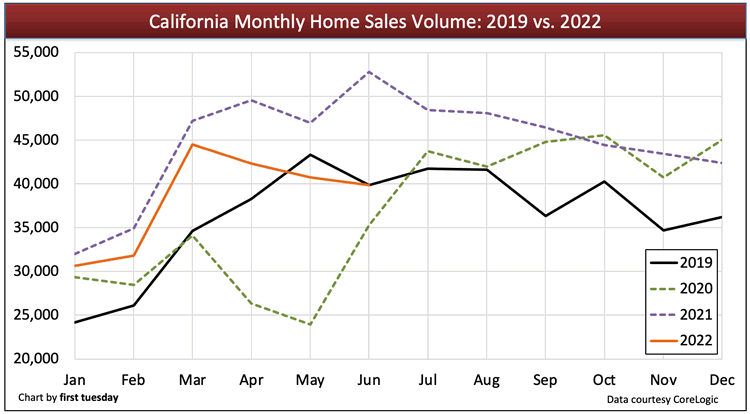
|
California’s Home Sales Volume Decline is Fully Underway as of June 2022 California home sales volume continued to fall back in June 2022, down from both the prior month and a year earlier. This was the third month in a row of decreasing sales, atypical for the spring sales cycle. Sales volume usually rises from an annual low point in January to a peak mid-year. Therefore, yet another month of lower sales volume is sounding alarm bells for sellers — and future pricing. 39,900 new and resale home transactions closed escrow in California during June 2022. The number of homes sold in June was 2% below the prior month and 24% below a year earlier, amounting to 13,000 fewer sales. Year-to-date (YTD) home sales volume can be a strong predictor of annual sales volume. As of June 2022, YTD sales volume is 13% below a year earlier. For reference, the rapid pace of sales experienced in California since 2020 began to taper off in the second half of 2021, continuing in 2022. Due to the uncharacteristically steep annual sales volume rise that occurred early in 2021 — fed by buyer fear of missing out (FOMO) on low inventory and homebuyers taking advantage of historically low interest rates and stimulus boosts — the typical year-over-year comparisons are not as useful today. Instead, consider comparing today’s sales volume to the last “normal” year we experienced: 2019.
Here, we see the path of home sales volume in 2019 (the black line) alongside sales volume thus far in 2022 (the orange line). The dashed lines display the abnormal years of 2020-2021, which were distorted by Pandemic Economics. While sales volume started off 2022 at a faster pace than 2019, after peaking in March, it has quickly tapered off to below 2019 levels. Thus, after two years of irregular home sales volume, expect sales volume in 2022 to end the year slightly below 2019, tempered by rising interest rates, a still-recovering jobs market — and more sober homebuyers. The government’s pandemic-era efforts to bridge the gap are waning At an annual rate, 2021 ended with 536,600 annual home sales in California. This was a significant 97,400 more home sales than took place in 2020, amounting to a 22% annual increase. 2021’s strong year for home sales volume was still 29% below the peak year for sales volume in 2005. However, this heightened performance follows several years of flat-to-down sales volume (the bumpy plateau recovery following the 2009 foreclosure crisis and financial crash). Why were 2021’s home sales volume and home price increases so strong compared to recent years? The federal government introduced a number of measures to create a bridge for consumers, to get them from the moment of the 2020 recession through to the end of the pandemic response. The result was a buoyed housing market, with low interest rates and extra cash providing a launching pad for renters, homebuyers and investors to take the real estate plunge. The government’s steps included:
All this federal action helped drive up enthusiasm (and prices) not just for real estate, but for assets of all types. However, while the government created a bridge to carry consumers across the pandemic-era recession, the bridge also delayed the inevitable. While the government’s stimulus measures were coming to an end, the economy was on the return path towards recession.
|
| © 2006 - 2022. All Rights Reserved. |
